Mutus Liber Magophon Hypotypose
Buy me Coffee
MUTUS LIBER MAGOPHON HYPOTYPOSE
(Pierre Dujols) Nourry Bookstore, Paris Vth
(1914) The plates reproduced in the body of the text are those of the Mutus Liber of the original edition of 1677,
by Pierre Savouret in La Rochelle L.AT
This title, although it seems so, does not have the slightest pretension. It is quite technical, the only suitable and genuine subject, because it outlines, in its conciseness, the plan of our study. A hypotyposis (from νπο, under, and Τνπος, imprint, emblem) is an explanation placed under abstract figures. But the Mutus Liber is a collection of enigmatic images.
An absurd legend has formed around the Mutus Liber. A School—which is hermetic only in name—has given this work a reputation for impenetrable obscurity and, on this account, venerates it as a sacrament, without understanding it. It is a mistake; just as to translate Mutus Liber by the Silent Book, without words, is a philosophical misinterpretation. All the signs adopted by human industry to manifest thought are verbs. The Latins—this word understood properly—call drawing, painting, sculpture, and architecture by means of which the Hierogrammates reserve for the elect the mysteries of Science, mutae artes , that is to say, the symbolic arts.
What is a symbol? Ενμδολη is a convention;Ενμδολον, a sign of recognition. A symbol is therefore what we call today a “Code”, a tacit system of writing adopted for diplomatic, even commercial correspondence, telegraphic and semaphoric communications, etc. For an illiterate man, every book is mutus . A volume in Hebrew, Sanskrit, or Chinese is a mutus liber, a silent book, for the greatest number, even though they are instructed in their own language. So you have to get used to this very simple idea that the Mutus Liber is a book like the others and that it can be read in clear, if you have the grid.
Moreover, works of alchemy, in verse, in prose, in Latin, in French or any other idiom, are themselves only cryptograms. Although written with the banal letters of the alphabet and the common vocabulary, they nevertheless remain indecipherable for anyone who does not know the key. To tell the truth, between the two steganographic procedures, that of the Mutus Liber is still the most transparent, because the objective image is certainly more telling than literary tropes and figures of rhetoric, especially in a subject as experimental as that of chemistry. .
By pinning these few pages of comments to the allegorical plates of the Mutus Liber, we have proposed, without leaving the philosopher's mantle, to facilitate their reading, through a sincere interpretation, for true inquisitors of science, honest, patient, laborious as well as the diligent bees, and not the curious, idle and frivolous, who pass their lives fluttering uselessly from book to book, without ever stopping at any one to extract the honey-like substance.
Oh what! grammar, geography, history, mathematics, physics, chemistry and the rest become accessible only after long and painful efforts, and one would like to enter the "King's Palace" without observing properties and submit to the laws of etiquette! A hasty and superficial reading cannot replace austere and serious study. The profane sciences themselves can only be penetrated and assimilated after sustained and prolonged work.
It may be objected that the University has illustrious grammarians, geographers, historians, mathematicians, physicists and chemists, but that no alchemist has ever been mentioned there. And if the alchemy associate is unknown, it's because alchemy is a chimera. This ad hominem argumentis not without reply: a hidden thing is not therefore non-existent, and alchemy is an occult science; we would say better: it is the entire occult science, the universal arcana, the seal of the absolute, the magic spring of religions, and that is why it has been called the Sacerdotal or Sacred Art.
There is in all the beliefs imposed on the vulgar by means of an appropriate mythology: Bible, Vedas, Avesta, Kings, etc., a positive substratum which is the seat of the sanctuaries of all the cults spread over the globe. This mystery, recognized in the catechism as the prerogative of the Pontiffs — who are not public dignitaries — is alchemy on all levels: physical and metaphysical. The exclusive possession of the sacrarium is the strength of the Churches; so they watch over the "Masonic secret" with anxious and jealous care, assisted by a suspicious police and censorship.
We are not advancing anything by chance, and yet these allegations may seem gratuitous, because implausible, given that, since the invention of the printing press, hermetic books have always been published freely with the license of civil and religious authorities. And nothing, in fact, opposed the dissemination of these libels written in known languages, but within; to such an extent that the greatest chemists of the School—from Lavoisier to Berthelot—have broken their heads without result. Is this not the place to recall the contemptuous apostrophe of Artephius and the haughty warnings of the Adepts who declare, bluntly, to write only for those who know and to deceive the others!This is how the "Christ" is spoken of in the Gospels, and the disciples are modeled on the "Master".
But, to be a hidden science, alchemy is not less a real science, exact, in conformity with the reason and, moreover, rationalist. There have always been "gold makers"; the "glass gentlemen", who enjoyed such high consideration, were hermetists. And even today, transmutation still works miracles. Following sensational and not far off debates, it was said – and in the midst of what amazement – that the Administration of the Mint would have seized, without any other form of trial – and for good reason! — the production of a contemporary alchemist: — "You must not know how to make gold!" they say to him with a threatening air, sending him away with his hands free, but empty. Is it therefore forbidden to be learned,Or would alchemy be a state secret? It would not lead to this naïve conclusion that the ministers who succeed one another are familiar with Kabbalah. Kings reign, but do not govern, according to a famous aphorism. And it does seem, at times, that there is still, behind the scenes, some gray eminence who pulls the strings! The famous "Gatetas du Temple" is perhaps not so abolished as one supposes, and there would be a surprising book to write on the watermarks of banknotes and the abbreviations of coins.
But in this case, it will be said, why has gold become so rare that social life is paralyzed? Species have not evaporated, they have moved, and we have to wait for them to return to their starting point by an inverse economic movement.Only, being too slow in this return can have incalculable consequences.
The politics of the peoples is regulated by a secret metallic pact which cannot be violated without causing the most serious international complications. We will therefore draw tickets with a vengeance; but no more gold coins will be minted. And yet, it is not that gold is lacking: it is displayed ostensibly, and with what pomp, on innumerable shoulders, around wrists, fingers and even legs whose elegance and aesthetics leave sometimes wanting. Nothing would therefore be easier for the state than to exchange its paper for precious material and put the “coins” to work. It's paradoxical, but it's the truth. There is therefore a profound reason based on wisdom for this momentary eclipse of gold coins. "Gold is what gold is worth", says an adage.If the strike of it were lawful to nations which have exhausted their normal reserves, the overabundance would entail their debasement. The fiduciary standard would no longer offer any guarantees and would amount to counterfeit money. The financial equilibrium would be broken; it would be the death of business, world ruin. This is why the "natural" production of gold is itself limited, so much so that the concession of new mines is refused and even its extraction with poor yield from fluvial and other sands.
However, the hour is near when science will fully claim all its rights, and when the occult will again become manifest as it once was.The scholar Girtaner announced it by basing his opinion on unknown but certain laws: “In the 20th century, Chrysopée will be in the public domain”. This considerable event is obviously subordinated to a social status quite different from that which governs us; but we are going strong, the world is turning fast, and who can foresee tomorrow's charter!
However, if alchemy were limited solely to the transmutation of metals, it would be an invaluable science no doubt from the industrial point of view, but rather mediocre in the philosophical sense. In reality, this is not so. Alchemy is the key to all knowledge, and its full disclosure is called upon to upset from top to bottom human institutions, which are based on lies, in order to reestablish them in truth.
These preliminary considerations seemed appropriate to us, before charitably taking the reader by the hand to lead him through the inextricable meanders of the labyrinth.
As our desire is to be useful to researchers, but as we cannot, in a few pages, write a technical treatise, we must, before entering into the subject, direct the disciple towards the work which seems best to correspond to the figures of Mutus Free. Most of the manipulations indicated in this collection of symbols are fairly well described by the most notorious of philosophers, in "The Open Entrance to the Closed Palace of the King" by Eyrénée Philalèthe.
It is not that there is nothing more to add to it. Far from it, on the contrary. The practice of Philalethes, presented under a pleasant and persuasive guise, is among the most subtle and perfidious fictions of hermetic literature. It nevertheless contains the truth, but as the poison sometimes conceals its antidote, if one knows how to isolate it from its pernicious alkaloids. If necessary, we will report the pitfalls as they arise under our feet.
The Mutus Liber is composed of fifteen plates of emblems, some truthful, others sophistical, and arranged in one of those beautiful disorders which, according to Boileau's precept, is an effect of art.
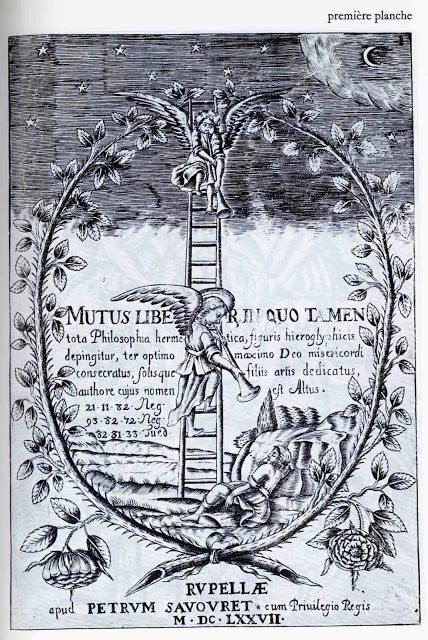
The first plate, which serves as a frontispiece, is truly capital. On his understanding depends all the success of the work. We see there, in a cartouche formed of two intertwined rose bushes, a man asleep on a rock where stunted kermes vegetate. Clear water pours out with metallic reflections. Beside the sleeper, on a ladder—the Staircase of the Sages—two angels sound the trumpet to wake him up. Above, a night sky conductive to rest: the stars shine and the moon cuts out its cornucopia.
This initial page would include a comment not attributable to the educated author, but to the profane artist who, in the reproduction of the figures, has committed, without suspecting it, a serious misinterpretation.And it is already a great point to point it out, without it being necessary to insist on it further. The hermetic glosses will inform the disciple of this, who will not deem it useless to inquire there.
The Sleeping Man is the subject of the work. What is this subject? Some say it is a body; others say it is water. Both are in the right, because a water, called "the silver beauty", springs from this body which the Sages call the Fountain of the Lovers of Science. It is the mysterious salting of the Druids, the matter which gives salt (from salt to sal and agere produce).The secret of the magisterium is to release the sulfur from it again and to use the mercury from it, because everything is in everything. Some artists claim to go elsewhere for this effect, and we will not deny that cinnabar hydrargyrum can be of some help in the work, if one knows how to properly prepare it oneself; but it should only be used wisely and appropriately. For us, whoever manages to open the rock with the rod of Moses, and this is no small confidence, has found the first operating key. Then, on this abrupt stone will bloom the two roses which hang from the branches of the wild rose, one white and the other red.
We will be asked, and not without reason, what magic verb is capable of snatching from the arms of Morpheus or Epimenides, who seems really deaf to the cries of whelks. This Word comes from God, carried by the angels, the messengers of fire. It is a divine breath which acts invisibly, but certain, and it is not hyperbole. Without the help of heaven, the work of man is useless. Trees are not grafted or grain is sown in all seasons. One thing at a time. The philosophical work is called Celestial Agriculture, it is not for nothing; one of the greatest authors signed his writings with the name of Agricola, and two other excellent adepts are known by the names of Grand Paysan and Petit Paysan.
The disciple will therefore have to meditate for a long time on this first plank, to compare it with the apologues in the vernacular. May he be happy enough to hear the voice of heaven himself; but let him know, beforehand, that he will listen to it in vain, if he is not nourished himself with the Holy Letters.

The second plate is not in the order of operations. It represents the Egg of the philosophers, and yet nothing, up to now, has been able to reveal the elements which must compose it. To give an idea of this, we must deliberately step over a number of symbols.
Every egg contains a germ—Purkinje's vesicle—which is our salt; the yolk, which is our sulphur, and the albumen, which is our mercury. The whole is enclosed in a matrass which corresponds to the shell. The three products are personified here by Apollo, Diana and Neptune, the God of the Pontic waters.
The tradition wants that this matrass is contained in a second, and this one contained in a third made of the wood of an old oak.Flamel expressly says, "Note this oak," and Vico, chaplain to the lords of Grosparmy and Valois, recommends it with no less interest. This insistence is significant, and we will recall that on the first plank, on the rock of the Sages grows the Kermes oak, the Hermes of the Adepts, because, in the Hebrew language, K and H are only the same letter, taken alternately for each other. But be careful, mineral kermes leads to the trap set by Philalethes, Artephius, Basil Valentine and so many others, and we must not lose sight of the fact that philosophers take pleasure in certain verbal collusions. Έρμης is the artificial mercury that amalgamates the compost.
The size of the egg matters. In nature, the egg varies from that of the kinglet to that of the ostrich;but, says Wisdom, in medio virtus . We must also say something about the philosophical glass. The authors speak of it little, and still with reserve. But we know from experience that the best is Venice. It must be of good thickness, limpid, without bubbles. They still used, in the past, the large glass of Lorraine made by the gentlemen blowers; but a good practitioner must learn to make his matras himself.
The lower figure of this second plate represents an athanor between a man and a woman on their knees, as if they were in prayer, which has led certain weak minds to believe that prayer intervenes in work as a ponderable element. This is an irrelevant factor here.The main thing is to use expedient materials; but the impulse of the creature towards the creator can favorably influence the directives, since the light comes from God. Let us nevertheless free ourselves from these suggestions, which are not very effective in practice. The prayer of the artist is even more work, obstinate work, often hard, dangerous and incompatible with hands that are too white. Count therefore above all on the improbus labor .
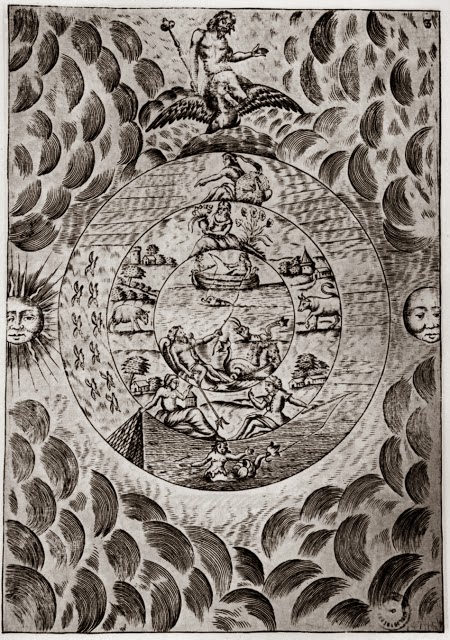
Plate three is no longer in its place. It leads us into Neptune's empire. We see the dolphin dear to Apollo frolicking in its waves, and fishermen on a boat tending their gear. In another nave, a man is reclining in a nonchalant pose. In the second circle, a landscape, with, on one side, a ram; on the other, a bull, which we will find later and study at a more opportune time. Below, on the left, a woman holding a basket which is the symbol of the lattice lantern of the philosophers; on the right, a man throwing his line into the sea which is in the third circle (the one that encloses the other two). The third circle is animated by a flight of birds to the left; a mermaid at the bottom, and Amphitrite at the top.In the margins, the sun and the moon, and hovering over this nautical scene, Jupiter carried by his eagle. All this figuration aims to demonstrate that the operator must deploy all his faculties and implement all the resources of the art to capture the mystical fish, of which d'Espagnet speaks.
The author should have first taught us how to weave the net necessary for this miraculous catch. Let's correct his omission: The windlass must be braided in very fine asbestos mesh, which has the property of being incombustible and remaining unalterable. The device well laid out in the deep waters, we will provide ourselves with a lantern whose brilliance will attract the prey into the nets. We can, according to other symbols, use the line;but the mystery is in the preparation of the purse, and the word is appropriate, for it is nothing less than taking the golden fish.
The secret of this operation will be found in a classic work entitled Ariadne's Net. , because we cannot summarize the process in a few lines within this restricted framework. As for the manner of lighting the magic lantern indicated by the basket, it is described only in very rare works and in a confused manner. So we need to say a few words:
Some authors, and not the least, have claimed that the greatest operative artifice consists in capturing a ray of sunlight, and imprisoning it in a bottle closed with the seal of Hermès.This crude image caused the operation to be dismissed as something ridiculous and impossible. And yet, it is true to the letter, so much so that the image becomes one with reality. It's rather incredible that we haven't noticed that yet. This miracle, the photographer accomplishes it in a way by using a sensitive plate that is prepared in different ways. In the Typus Mundi, published in the 17th century by Frs. of the Society of Jesus, we see an apparatus, described again by Tiphaigne de Laroche, by means of which one can steal fire from Heaven and fix it. The process could not be more scientific,
The eagles flying to the left, in the great circle, designate the sublimations of mercury.It takes three to seven for the Moon, and seven to ten for the Sun. They are indicated by the flight of birds and indispensable, because they prepare the nuptial dress of Apollo and Diana, without which their mystical union would be impossible. This is why Jupiter, the God who governs the eagle, presides over these operations.
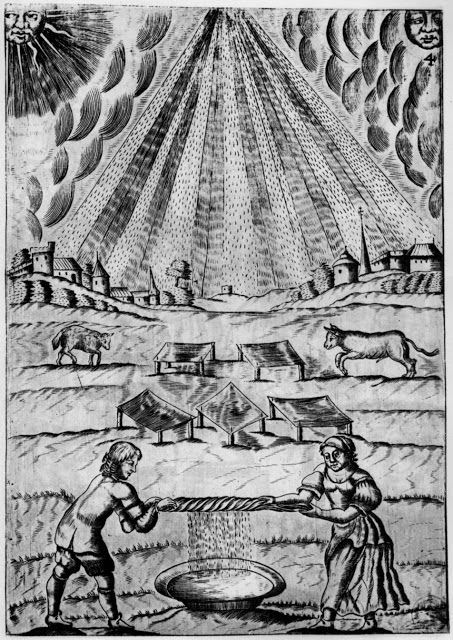
The fourth plate shows how the collection of theflos coeli operates . Sheets are stretched on stakes to receive the celestial dew. Below, a man and a woman operate the twist to express the divine liquor, which falls into a large vase placed for this purpose. On the left, we see Aries; on the right, Taurus.
The flos coeli has tortured the minds of bad prompters. Some saw in it a kind of magical influx, because for them, magic is a supernatural power acquired by the competition of spirits, good or bad. The others, more realistic and closer to the truth, recognized the morning dew in it. The flos coeli, have no relation to astrological symbols.is called, in fact, the water of the two equinoxes, from which it has been deduced that it is obtained in spring and autumn and is a mixture of the two fluids. Some, thinking themselves wiser, were going to collect this mysterious product in a kind of algae or lichenoid whose vulgar name is nostoc. In the Seven Shades of Philosophical Work, Etteilla, who was perhaps better than his reputation, seems to have obtained some satisfactory result from a similar foam; but you have to read his booklet with good glasses.
The Rose-Croix were called the "Brothers of the Cooked Dew", according to Thomas Corneille, a good hermetist as well as his brother, the great tragic.Nevertheless, Philalethe disdainfully mocks the collectors of dew and rainwater, in which, notwithstanding, the Abbé de Vallemont recognizes some virtue. It is up to the disciple to form an opinion according to his own judgment. But there is no doubt that a secret agent, known as "Celestial Manne", plays an important role in the work.
We must declare, in good faith, that the Aries and the Taurus of the board, which we always take for the signs of the Zodiac under which we must collect the flos coeliAries is Hermes Criophore, which is the same as Jupiter Ammon; and the Bull, whose horns draw the crescent, attribute of Diana and Isis, who identify with the cow Io, lover of Jupiter, is the Moon of the philosophers. These two animals personify the two natures of the Stone. Their union forms the Azim of the Egyptians, the Asimah of the Bible, a hybrid monster designating the orichalcum, the brass or bronze oryx, the Phalaris or bronze bull, the golden or chrysocale calf which Certainly differs from the Mannheim Similor and has something of the Melchior in it. Finally, to be honest, it is the electrum of poets; but it is necessary to understand this word which contains the magic arcanum.Philalethes teaches that the gold of the hermetists is, in certain points, similar to common gold. betulus , which is, in short, the same word as vitulus , the Latin name for calf, and as vitellus , the yolk of the egg. Unleavened bread was its hieroglyph. The priests on the banks of the Nile never touched the bread of the sacrifice with a sharp instrument of steel or iron: they made it a case of sacrilege. Hence this ancient custom, still in use, of breaking the bread. Similarly, in the Catholic rite, the officiant cuts the host with the vermeil paten. All this logomachy hides the vermilion of the Sages, or the philosophical amalgamation of mercury, gold and silver of art, rendered indissoluble by theflos coeli .
We will learn, not without surprise, that the bullfights are a dramatic figuration of the Great Work. All games have a hermetic origin. The red cockade that the animal wears, and to which is attached a bonus granted to the winner, is the image of the Rose of the Philosophers. The big deal is being a good Matador. Also, according to the Spanish tradition, “to gain access to government, one must triumph over the bull”—the mystical bull, of course. This victory conferred "chivalry", true nobility, that of Science, and consequently the scepter. This is why, under Louis XIII, the leaders of the Kabbalah of State were nicknamed the “Matadors”. The species is not extinct, although erased and inapparent.
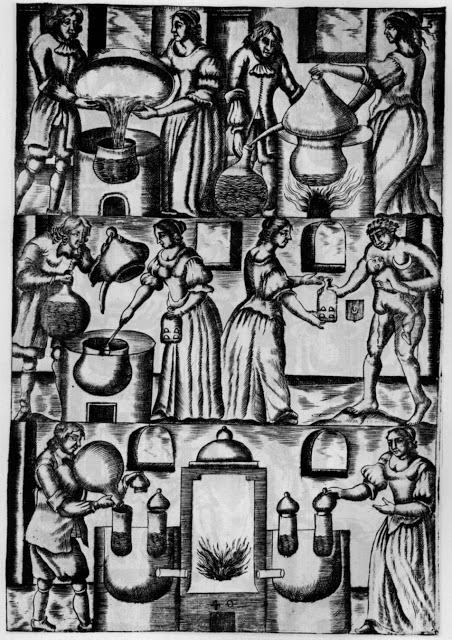
The fifth plate introduces the disciple to laboratory operations. There is a series of varied manipulations. It is visible that it is the coction of the liquor collected in the previous plank. A man and a woman ostensibly for it into a pot on the fire. In the figure below, the man adds a viscous product to it and holds, with the other hand, a substance which it is not difficult to discover, if we consider that the egg of Hermogenes is similar to the others. On the same plane, next to it, a naked figure, decorated with a half-moon and attached to a child, receives a bottle in which four small triangles can be seen. They represent the proportions of the elements used, namely one of sulfur for three of mercury. The lunar body intervenes in this operation;it is indicated by a shield bearing a silver moon on a field gules.
The Moon of the philosophers is not always silver, although this metal is suitable for work at a certain time. To confuse the profane, the Adepts give this name to mercury and its salt, the preparation of which presents the greatest difficulties. For mercury to be suitable for operations, it is essential to animate it. This animation is done by means of sulfur prepared for this purpose. One will find in Philalethes practical indications which, however, should not always be followed word for word. It is true, however, that mercury must be purged of its heterogeneous elements by separating the pure from the impure, the subtle from the thick.We see, in this panel, the woman preparing to skim the compost. It is a presentation loaded with work, but accurate in substance. In the work, it is the feminine element, in fact, which operates the selection by its constitutive virtues; but the artist must lend his hand to it and assist nature with caution.
The other figures represent the digestions and distillations. We shall not teach the sensible reader anything new by telling him that a man stuffed with chemical formulas and capable of solving all school problems on paper has no title to call himself a chemist. It is therefore necessary that the practice accompanies the theory, one is the consequence of the other. Laboratory practice alone gives mastery, for what is practice if not control of theory. The rigor of the first straightens out the mistakes of the second. The disciple should therefore strive to realize all his concepts.

Plate six is the continuation of plate five. It will be noted that the operations are always carried out there by a man and a woman, symbolizing the two natures. The outward action of these two agents indicates the inner work of bodies reacting on each other. In the first figure, the female agent plays a passive role, and the male agent an active role. This is sulfur; that, the moon.
We will no doubt wish to know what this mysterious sulfur is of which philosophers always speak, without designating it otherwise. It is the sulfur of metals. The secret of the art consists in extracting it from the male bodies to unite it with the female bodies, which presupposes their prior decomposition.Current science seems to regard this fact as an absolute impossibility. Great chemists of the 18th century demonstrated, in communications addressed to academic bodies, that the operation is feasible and that they had carried it out. We have in our hands a magnificent silver sulfur obtained by a similar means and which is very similar to the tincture of the Sages. But, to achieve this result. it takes some practice and in-depth knowledge of the mineral kingdom.
Beware of authors who speak of grindings, decantations, separations obtained by what they call "sleight of hand". Manual action contributes to the results only in the manner of a cook preparing her pot-au-feu.When the ingredients are in the pot, the water cooks the compost, brought to the required temperature by the outside fire. The coction finished, there is only to extract the products and to use them according to the formula. But any intervention is detrimental and harms the work.
We must particularly point out the figure representing the hermetic rose obtained by the previous sublimations. There would be a lot to say here. All treatises on alchemy are only “Romans of the Rose”, both literally and figuratively. The first care of the artist consists in distinguishing between the true and the false. This dominates and constitutes hermetic literature.
What is the Rose?It is the flower of the philosophical tree that bears the fruit. Now, the tree of the philosophers is vegetable mercury; the Rose is therefore the efflorescence of the metallic sap set in motion by the external fire, which excites the internal fire of the bodies. But the Sages speak of two different fires devoted to this function. The disciple must therefore think that there exists, besides natural fire, another agent so called, and this secret fire is the ferment of metals, which plays in work a role analogous to that of leaven in the baker's dough. But let the addition of this new element not disturb the thought of the son of science.As leaven is made of acidified flour and water, so the ferment of metals is a product of sulfur and mercury, brought by art to a proper state.
Our plate shows us a second smaller rose, and a third even smaller one. Would there be several roses? Yes and no. There are two roses in principle, depending on whether one operates for gold or silver; and, basically, there is only one. However, the Mutus Liber presents three well-defined ones. That's right; but they are daughters of each other, that is to say of three different powers. In the system of coction, Philalethes teaches that one first obtains the white rose, which he calls the moon; yellow or saffron rose; the red or perfect rose.We do not use this author's exact terminology; but we speak clearly enough to make ourselves heard.
Obtaining roses is subject to putrefaction. Putrefaction gives rise to a succession of colors. The first is the quarter note; it is the key to others. No black, no putrefaction; and without putrefaction, no transformation. If such an accident were to occur, it is because the materials brought into contact do not have the desired qualities or are poorly prepared. See Philalethes for the rest and take only the end.
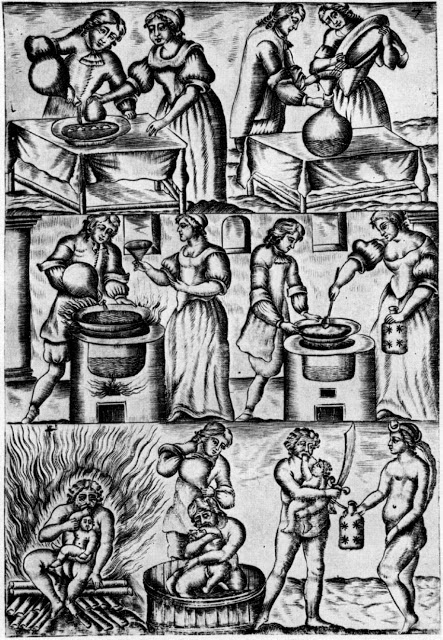
The seventh plate is very important, but it is difficult to understand. We find here the four small triangles which indicate the relations already explained; but we come to a delicate operation, because it is here that Saturn devours his child.
We know the fable of Saturn and Jupiter. What is Saturn and what is Jupiter? The chemical nomenclature, which one finds with the authors, will let you know to which metals these two names are suitable. But we will point out, in all conscience, that the Saturn and the Jupiter of the Sages are not the same as those of the profane chemists. Be careful, and don't go and do plumber's or tinsmith's welding. We do not work on raw products, and even though they are all borrowed from the family of metals, they are suitable for the work only after having undergone a preparation which makes them "philosophical".
If we adopt the wet method, we will proceed according to the art by bringing our two elements into contact, so that one absorbs the other, which will give a new product which will hold both, without it it is now possible to start it, at least in a chemical way. The dry way supposes, obviously, a combination obtained by a process adapted to the nature of the bodies. But let's not mix the two paths: liquids unite with liquids, and solids with solids. When Saturn has accomplished his horrible feast, one must, says Philalethes, pass over him all the waters of the flood, not so as to drain him, but to correct the effects of laborious digestion by eliminating the toxins resulting from fermentation. . This is called "whitewashing the nigger".
In this operation, fire plays a certain role. One of the figures represents Saturn crunching his son in the middle of a brazier. The greatest attention must be paid here to the discourses of the philosophers. This assures us that elementary fire is the destroyer of bodies, and that their fusion volatilizes the soul; that one declares that the Sages burn with water, but at the same time prohibit corrosive liquors, such as acids. The disciple therefore finds himself locked in a vicious circle, from which it is very difficult for him to emerge to his advantage. It is necessary to take the average of the two doctrines to agree them together. There is a water that contains the fire of Heaven; it is dew, gold flos coeli, which we have seen drawn in a previous plate. We know that dew contains an acid principle which literally burns. Objects subjected to its action soon crumble into dust. We must observe, however, that the philosopher's dew differs, in reality, from the common dew. It is, however, formed from the real tears of the Aurora united to an earthly substance, which is the subject of the work.
The operation is tough, but effective, if you persevere, because you have to try several times. This washing with plenty of water strips the body of its impurities, corrects its humors and makes it ready for subsequent operations. It is then distilled hermetically so as not to lose any of it; the salt is precipitated from it, which presents itself in small very hygrometric crystals, and which must be removed at once from the influences of the air. That is why it is locked up, as another figure shows,

The eighth plate shows us the mercury of the philosophers realized, while the second board presented only the constituent elements. He is the product of the Sun and the Moon which are at his feet. The eagles fly around him because he is subjected to the necessary sublimations in the matrass, which is indicated at the bottom of the plate by the athanor where the egg has been placed to incubate.
The mercury of the philosophers, animated and sublimated according to the rules, must circulate for a long time in the vase before producing the happy effects which are expected of it. But there are several mercurys in the work, and Philalethes points out a second one in particular, under the name of virgin's milk. This one differs from the first in something, although they are both of the same essence. Philalethes, Ripley and others go so far as to say that it is common mercury. Basil Valentine, on the contrary, banishes him with a curse. Some believed that virgin's milk could be obtained by a combination of the two.We know an artist who achieved this tour de force for the pleasure of overcoming the difficulty, without pretending to draw any other consequence from it. We are therefore able to certify the operation as feasible, which does not imply that we adhere to its use in practice. We must welcome with the greatest reserve all the bizarre names imposed by philosophers on certain ingredients. These different epithets serve only to disguise the sequence of operations. In such a way that the same product, depending on whether it is or is not exalted, bears one name or another.And it is true, after all, that alcohol, though extracted from wine, differs from it both in name, and in appearance, and in potency, and in effect, just as wine differs from grape, from which it is drawn... according as he is or is not exalted, bears one name or another. And it is true, after all, that alcohol, though extracted from wine, differs from it both in name, and in appearance, and in potency, and in effect, just as wine differs from grape, from which it is drawn... according as he is or is not exalted, bears one name or another. And it is true, after all, that alcohol, though extracted from wine, differs from it both in name, and in appearance, and in potency, and in effect, just as wine differs from grape, from which it is drawn...
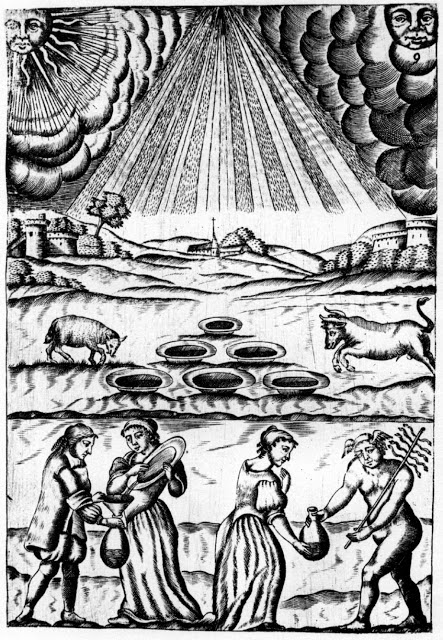
The ninth plate takes us back to the flos coeli . Why this return, and why resort to it again, since we had supplied ourselves with it? It's not that the author of Mutus Liber wants to send us back to the countryside to get another one; but he was obliged to repeat the symbol of it, from the moment that this celestial agent must enter into a new combination.
We see, in one of the figures on this plate, Mercury buying a pot of this divine water from a peasant woman. It is therefore that he needs it for some use. Philalethes effectively prescribes washing the mercury several times, so as to make it lose part of its oily nature.He carefully describes this operation, which is accomplished with celestial water brought to a certain temperature, moderate nevertheless, because it takes a little too much heat for the igneous part of the flos coeli return to the path of the stars. Philalethes is a great master, his word is authoritative and he presents the work with such convincing ingenuity that no suspicion of fraud will ever cross your mind. But we must vent here a ruse: This author deliberately confused, in his work, the dry and the wet way. It would therefore be a mistake to apply to one technique what is suitable for the other. But, this remark being made, we recognize that the astral mind plays a permanent part in the operations.
And since we are using Cyliani's phrase, let's stop at the implausible interpretations to which this fairly recent term has given rise. Yesterday writers saw in this astral spirit a magnetic emanation from the operator. According to them, it would be necessary, for a determined period, to undergo a physical and moral training, to practice successfully this kind of fakirism or yoga. The strength of the product must be proportional to the power of the fluid, so that the projection powder obtained multiplies by 100, 1000 or 10,000, etc., depending on the artist's potential. These fantasists thus claim to impregnate matter with the astral spirit as one charges an accumulator with electricity. This is where the misunderstood and wrongly applied analogy leads.We will not name these singular theoreticians whose sincerity is respectable; but we had to point out the fact to warn the studious disciple, and too confident, against the risky readings of authors without mandate and without consecration, who have never produced anything but books, but therefore pass for Masters.
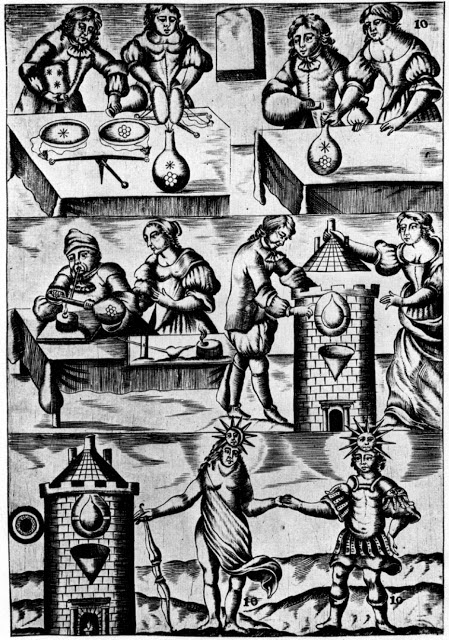
The tenth plate represents the conjunction. The first figure exposes, in the pans of a balance, on one side, the salt indicated by the star, on the other the sulfur indicated by a flower which, with the heart, forms seven petals. These are the ratio proportions. A man pours on this flower a liquid enclosed in a flask. It's mercury. He holds, with the other hand, another container full of astral spirit to use it according to the case. The woman places all these products in a long-necked matrass; but let us remember here what we have said of the role of woman in the work: the two agents thus personified are the materials themselves, and the various accessories which accompany them declare their state of exaltation.
In the second row, the artist seals the matrass with the seal of Hermès. He presents the neck to the flame of a lamp, so as to bring the glass back to a pasty and ductile state. He must then stretch it carefully so as to reduce it to the desired point, while ensuring that there is no capillarity through which the spirit of the compost could escape. Things being there, after having cut the glass, he reverses on itself the adherent part of the matrass to form a thick bead. Today, this operation is carried out very easily with gas, using a blowtorch. Some practitioners, of consumer skill, employ an automatic process of greater perfection. Finally, whatever the means adopted, the egg is then placed in the athanor and the coction begins.
We will say nothing of the athanor. The Mutus Liber presents its form and internal arrangements. Philalethes describes it carefully We will only add one important remark to the words of this author: the construction of the stove is partly allegorical, and there is much to learn from the point of view of the conduct of the fire and the regime of the work . For the latter, the Secret Work of the Philosophy of Hermes, attributed to d'Espagnet and quoted with advantage, will be useful to follow, because there is the Zodiac of the Philosophers.
The last figure of this plate shows that the conjunction is operated: the Sun and the Moon are united. The work gave the required colors.They are synthesized here in a circle, first black, then white and finally yellow and red. The resulting product multiplies to ten, as stated in the numbers.
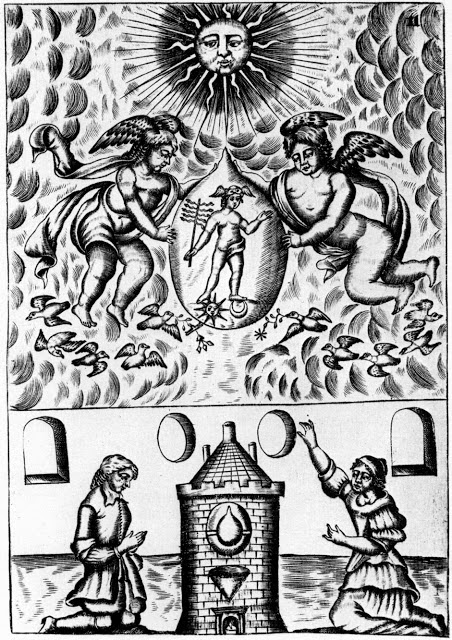
Plate eleven proclaims that the operator has entered into the regime of the Sun, that is to say, he has obtained the gold of the philosophers, which is not vulgar gold. We have already spoken of this mysterious gold. Although Jupiter plays a nominal role in the operating process, it is not tin disulphide, but real "mussive gold" or secret. We will confess, however, in all truth, that it is not a product of nature, but of art. Contemporary chemists - unduly taken for competence - believed to find it in the common vitriol, which they flattered themselves to make philosophical. They misheard Basile Valentin.The stroma of the dissolution of this salt, considered by them as a “nascent gold”, is only a fleeting mirage and leaves, on analysis, nothing but disappointment.
An author, famous in other ways and who enjoyed some prestige in certain circles—we must name Strindberg to warn against his wanderings—has failed in a puerile and ridiculous technique. His Livre d'Or is an aberration that called for a charitable silence. Philalethes and others those who are unaware of artificial gold to look for it in common gold, advise pointing out, however, this work as long and arduous.In this case, it must be subjected to difficult and dangerous manipulations, because this metal can be transformed into fulminate, and the Memoirs of the 18th century report several fatal accidents resulting from this preparation. But if the disciple is educated in the right school, he will avoid this sophisticated pitfall and operate hermetically; he will thus avert this formidable danger. The masters know how to reach the goal by following other paths, which they are careful not to indicate, but which are not unfindable, if one reasons with one's reason rather than with the erroneous books of the Sages. “It takes gold to make gold,” says the classic axiom; that's right, though there are two different golds to bring the Work to a good end.This plate shows that all the preceding operations are repeated here. It is necessary to raise the mercury to a higher degree of sublimation by means of the eagles, to redistill it to give it greater animation. though there are two different golds to bring the Work to a good end. This plate shows that all the preceding operations are repeated here. It is necessary to raise the mercury to a higher degree of sublimation by means of the eagles, to redistill it to give it greater animation. though there are two different golds to bring the Work to a good end. This plate shows that all the preceding operations are repeated here.It is necessary to raise the mercury to a higher degree of sublimation by means of the eagles, to redistill it to give it greater animation.

Plate twelve teaches us how we can carry this mercury to a higher scale. It is necessary, for this purpose, to begin again the imbibitions of flos coeli until the mercury, which is avid for it, is impregnated with it to saturation.
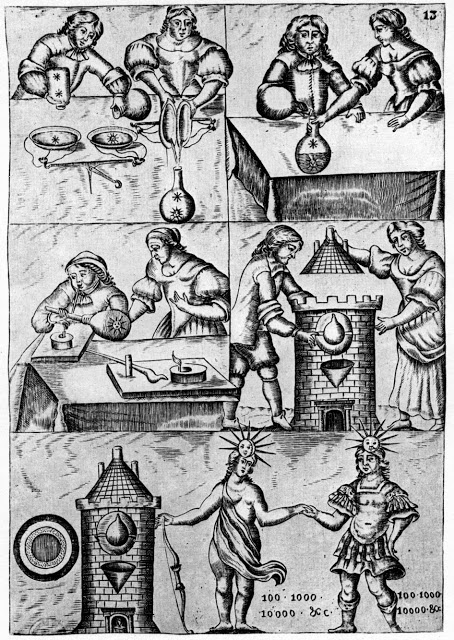
The thirteenth plate is a repetition of the tenth, for in the Work all the operations follow one another and look alike; but this new conjunction, which takes place with matters sublimated to the extreme, is nothing other than the beginning of the multiplications. The work is the same as that of plate ten and, in the coction, we will see the colors reappear. The duration of this decreases as the multiplicative power increases, so that in the end it only takes a day to obtain the result which, at the beginning, required months. The figures of this plate give the powers of transmutations obtained by the subsequent coctions.
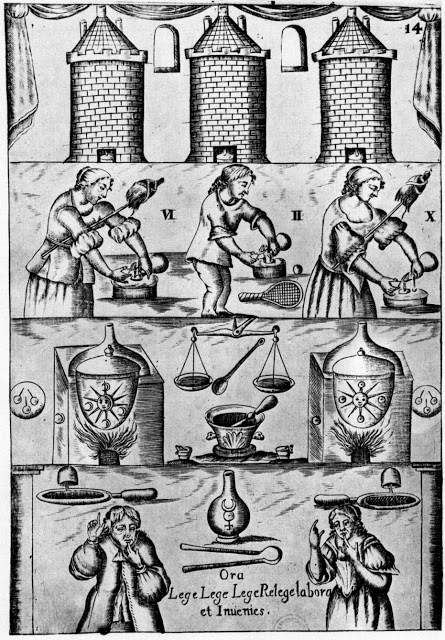
The fourteenth plate is mainly devoted to the instrumentation. We see the matras hermetically sealed with its bead, as we have described it; mortar and pestle for grinding; the skimming spoon; scales to determine the correct weights; the furnace of the first operations before the use of the athanor.
We recall that it is necessary to understand the crushings, the decantation, the skimming and all the rest in a philosophical way, although a trituration, a decantation and skimming are positively necessary to make the materials fit for work; but, subsequently, these operations take place by themselves and, so to speak, automatically by the reaction of bodies upon each other. The disciple will have to meditate deeply on the woman with the distaff, and follow her with sagacity in her manipulations; they are not indifferent and everything speaks to the true son of science. We cannot here transgress the wishes of the author, who testifies to his well-defined intention to let the symbol alone express all his thoughts.If these lines fall under the eyes of an Adept, he will approve of our reserve, which nevertheless borders on indiscretion.who potest capere capiat
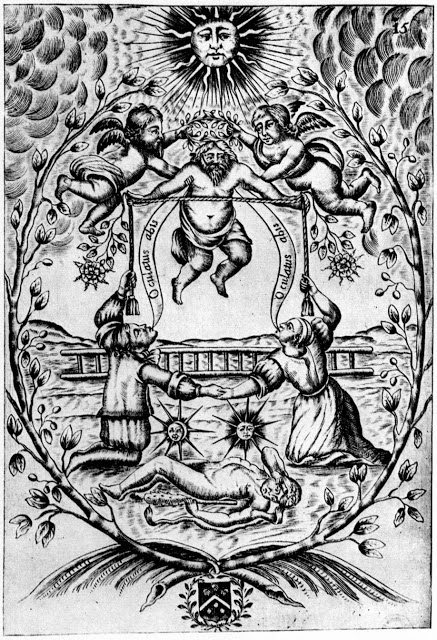
*
The fifteenth and final boardrepresents the apotheosis of Saturn, victorious over his son Jupiter who had dethroned him, and lies, inert, on the ground. It is the solarization of the basest of metals, its resurrection and glorification in the light. The two rosehip branches on the frontispiece are laden with red berries and white berries filled with active seeds, each of which has the power to turn all impure metals into gold or silver.So-called mystics — who deny the possibility of the metallic work and have found in the allegories of the philosophers only a treatise on asceticism of which they would be greatly embarrassed to explain each symbol — these pseudo-mystics see in this board a picture of the resurrection of man and his return to the heavenly homeland, and they are blissfully ecstatic over this discovery which they are not far from considering brilliant.
But if we become pure spirit again, it is therefore because our body contained its essence in its gross form and, under these conditions, we cannot deny metals the same properties. The spirit or the fire is everywhere and in everything: it lies in the seemingly cold flint, in the metals that are transformed into flammable and explosive fulminates at the slightest shock.However, transmutation is a phenomenon which makes the species pass from the lower plane to the higher plane, by means of a spiritual agent, a veritable seed called powder of projection. This marvelous product is obtained by the actual death and putrefaction of a metallic substance, which, transfigured, has the property of modifying in its turn the beings of its nature. These, under his action, likewise suffer a speedy death and resurrection, which raise them to their highest degree of dignity. The Hermetists compare this transformation to that of wheat. The grain is corrupted in the earth, assimilates the coarse elements of the soil and, by the work of a long digestion, moults them into pure wheat in the ratio of one hundred to one.This digestion is more or less activated by the atmosphere. In some climates the harvest takes place three months after sowing, and in the tropics the vegetation is almost instantaneous. It is therefore quite rational that a ferment endowed with great power and projected into bodies subjected to a high temperature, can cause them to evolve with a rapidity that is prodigious. by the work of a long digestion, moults them into pure wheat in the ratio of one hundred to one. This digestion is more or less activated by the atmosphere. In some climates the harvest takes place three months after sowing, and in the tropics the vegetation is almost instantaneous.It is therefore quite rational that a ferment endowed with great power and projected into bodies subjected to a high temperature, can cause them to evolve with a rapidity that is prodigious. by the work of a long digestion, moults them into pure wheat in the ratio of one hundred to one. This digestion is more or less activated by the atmosphere. In some climates the harvest takes place three months after sowing, and in the tropics the vegetation is almost instantaneous. It is therefore quite rational that a ferment endowed with great power and projected into bodies subjected to a high temperature, can cause them to evolve with a rapidity that is prodigious.
Evolution is the law of life: the mineral becomes vegetable and the vegetable animal, by way of intussusception;but this transit is subordinated to the mediation of an external agent, plant or animal. If, then, metals are thus allowed to pass from one kingdom to another, with the aid of an appropriate element, it is still more logical than a certain perfect and quintessential gold, brought back to its radical and spermatic, has the virtue of exalting and converting its homogeneouss into itself. Isn't this how the human germ, in gestation, assumes and transforms the substance of beings of a less noble origin? Nutrition is a continuous metamorphosis. Just as in the three kingdoms everything converges towards man, so in minerals everything ends up in gold. But we must not deduce from this that nature, in the long run, makes gold out of lead.
Gold is called the sun because, in Greek, aur is the light; it is the heaven of metals, the spiritualization of the species. The metals therefore become gold as, in certain respects, our body becomes spirit through the work of posthumous fermentation. Putrefaction, nauseating and hideous, is nevertheless the prestigious fairy that works all the miracles in the world. It is a gross error to believe that, in man, the soul abandons the body with the last breath. She herself is entirely flesh, for matter is a modality of spirit in different states under the dependence of a major and subtler spark, which is the God of every organism and if Science denies the reality of spirit because she has never found a trace of it , she dishonors her name.A corpse, rigid and frozen, is by no means dead in the absolute sense. an intense life,
We believe that we have accomplished our task with all the probity required, and have shed some new light in an obscure domain. It is now up to the disciple to complete the work. As for those who claim to acquire Wisdom without merit and only from some vile and contemptible obol, we say to them, like the Saint Jerome of the legend to the rich and idle Cratus: "Philosophy is not suitable for you".
For you, sons of Science, remember the eloquent sign addressed to you by the final figures of the fourteenth plate, and the gloss which closes the Mutus Liber: If you have understood, work in silence and close your mouth for a while longer. on the mystery.
MAGOPHON.